Important Airborne Lidar Metrics of Canopy Structure for Estimating Snow Interception
Abstract
:1. Introduction
2. Materials and Methods
2.1. Field Data
2.2. TLS Data Preprocessing and Canopy-Level Intercepted Snow Volume Estimation
2.3. Calculation of Standard Crown Metrics from Aerial Laser Scanning
2.4. Calculation of Novel Canopy Metrics from Aerial Laser Scanning
2.5. Analysis
3. Results
4. Discussion
4.1. Variable Selection
4.2. Study Assumptions and Potential Sources of Error
5. Conclusions
Author Contributions
Funding
Data Availability Statement
Acknowledgments
Conflicts of Interest
References
- Güntner, A.; Stuck, J.; Werth, S.; Döll, P.; Verzano, K.; Merz, B. A global analysis of temporal and spatial variations in continental water storage. Water Resour. Res. 2007, 43. [Google Scholar] [CrossRef]
- Rutter, N.; Essery, R.; Pomeroy, J.; Altimir, N.; Andreadis, K.; Baker, I.; Barr, A.; Bartlett, P.; Boone, A.; Deng, H.; et al. Evaluation of forest snow processes models (SnowMIP2). J. Geophys. Res. 2009, 114. [Google Scholar] [CrossRef] [Green Version]
- Varhola, A.; Coops, N.C.; Weiler, M.; Moore, R.D. Forest canopy effects on snow accumulation and ablation: An integrative review of empirical results. J. Hydrol. 2010, 392, 219–233. [Google Scholar] [CrossRef]
- Montesi, E.; Schmidt, D.; Montesi, J. Sublimation of Intercepted Snow within a Subalpine Forest Canopy at Two Elevations. J. Hydrometeorol. 2004, 5, 763–773. [Google Scholar] [CrossRef]
- Storck, P.; Lettenmaier, D.P.; Bolton, S.M. Measurement of snow interception and canopy effects on snow accumulation and melt in a mountainous maritime climate, Oregon, United States. Water Resour. Res. 2002, 38, 5-1–5-16. [Google Scholar] [CrossRef] [Green Version]
- Essery, R.; Pomeroy, J. Sublimation of snow intercepted by coniferous forest canopies in a climate model. IAHS-AISH Publ. 2001, 270, 343–347. [Google Scholar]
- Hedstrom, N.R.; Pomeroy, J.W. Measurements and modelling of snow interception in the boreal forest. Hydrol. Process. 1998, 12, 1611–1625. [Google Scholar] [CrossRef]
- Musselman, K.N.; Molotch, N.P.; Brooks, P.D.; Buttle, J.M.; Klein, A.G.; Pomeroy, J.W. Effects of vegetation on snow accumulation and ablation in a mid-latitude sub-alpine forest. Hydrol. Process. 2008, 22, 2767–2776. [Google Scholar] [CrossRef]
- Essery, R.; Rutter, N.; Pomeroy, J.; Baxter, R.; Stahli, M.; Gustafsson, D.; Barr, A.; Bartlett, P.; Elder, K. SNOWMIP2: An evaluation of forest snow process simulations. Bull. Am. Meteorol. Soc. 2009, 90, 1120–1135. [Google Scholar] [CrossRef] [Green Version]
- Pomeroy, J.W.; Gray, D.M.; Brown, T.; Hedstrom, N.R.; Quinton, W.L.; Granger, R.J.; Carey, S.K. The cold regions hydrological model: A platform for basing process representation and model structure on physical evidence. Hydrol. Process. 2007, 21, 2650–2667. [Google Scholar] [CrossRef]
- Kobayashi, D. Snow accumulation on a narrow board. Cold Reg. Sci. Technol. 1987, 13, 239–245. [Google Scholar] [CrossRef]
- Pfister, R.; Schneebeli, M. Snow accumulation on boards of different sizes and shapes. Hydrol. Process. 1999, 13, 2345–2355. [Google Scholar] [CrossRef]
- Schmidt, R.A.; Gluns, D.R. Snowfall interception on branches of three conifer species. Can. J. For. Res. 1991, 21, 1262–1269. [Google Scholar] [CrossRef]
- Brundl, M.; Bartelt, P.; Schneebeli, M.; Fluhler, H. Measuring branch defection of spruce branches caused by intercepted snow load. Hydrol. Process. 1999, 13, 2357–2369. [Google Scholar] [CrossRef]
- Satterlund, D.R.; Haupt, H.F. The disposition of snow caught by conifer crowns. Water Resour. Res. 1970, 6, 649–652. [Google Scholar] [CrossRef]
- Schmidt, R.; Pomeroy, J. Bending of a conifer branch at subfreezing temperatures: Implications for snow interception. Can. J. For. Res. 1990, 20, 1250–1253. [Google Scholar] [CrossRef]
- Martin, K.A.; Stan, J.T.; Dickerson-Lange, S.E.; Lutz, J.A.; Berman, J.W.; Gersonde, R.; Lundquist, J.D. Development and testing of a snow interceptometer to quantify canopy water storage and interception processes in the rain/snow transition zone of the North Cascades, Washington, USA. Water Resour. Res. 2013, 49, 3243–3256. [Google Scholar] [CrossRef]
- Roth, T.R.; Nolin, A.W. Characterizing maritime snow canopy interception in forested mountains. Water Resour. Res. 2019, 55, 4564–4581. [Google Scholar] [CrossRef]
- Hiemstra, C.A.; Liston, G.E.; Reiners, W.A. Snow Redistribution by Wind and Interactions with Vegetation at Upper Treeline in the Medicine Bow Mountains, Wyoming, U.S.A. Arct. Antarct. Alp. Res. 2002, 34, 262–273. [Google Scholar] [CrossRef]
- Webb, R.W.; Raleigh, M.S.; McGrath, D.; Molotch, N.P.; Elder, K.; Hiemstra, C. Within-stand boundary effects on snow water equivalent distribution in forested areas. Water Resour. Res. 2020, 56, e2019WR024905. [Google Scholar] [CrossRef]
- Bréda, N.J.J. Ground-based measurements of leaf area index: A review of methods, instruments and current controversies. J. Exp. Bot. 2003, 54, 2403–2417. [Google Scholar] [CrossRef]
- Song, C. Optical remote sensing of forest leaf area index and biomass. Prog. Phys. Geogr. 2013, 37, 98–113. [Google Scholar] [CrossRef]
- Bartlett, P.A.; MacKay, M.D.; Verseghy, V.D. Modified snow algorithms in the Canadian Land Surface Scheme: Model runs and sensitivity analysis at three boreal forest stands. Atmos.–Ocean 2006, 44, 207–222. [Google Scholar] [CrossRef]
- Friesen, J.; Lundquist, J.; Van Stan II, J.T. Evolution of forest precipitation water storage measurement methods. Hydrol. Process. 2015, 29, 2504–2520. [Google Scholar] [CrossRef]
- Eitel, J.U.; Vierling, L.A.; Magney, T.S. A lightweight, low cost autonomously operating terrestrial laser scanner for quantifying and monitoring ecosystem structural dynamics. Agric. For. Meteorol. 2013, 180, 86–96. [Google Scholar] [CrossRef]
- Deems, J.S.; Painter, T.H.; Finnegan, D.C. Lidar measurement of snow depth: A review. J. Glaciol. 2013, 59, 467–479. [Google Scholar] [CrossRef] [Green Version]
- Eitel, J.U.H.; Höfle, B.; Vierling, L.A.; Abellán, A.; Asner, G.P.; Deems, J.S.; Glennie, C.L.; Joerg, P.C.; LeWinter, A.L.; Magney, T.S.; et al. Beyond 3-D: The new spectrum of lidar applications for earth and ecological sciences. Remote Sens. Environ. 2016, 186, 372–392. [Google Scholar] [CrossRef] [Green Version]
- Timothy, D.; Onisimo, M.; Cletah, S.; Adelabu, S.; Tsitsi, B. Remote sensing of aboveground forest biomass: A review. Trop. Ecol. 2016, 57, 125–132. [Google Scholar]
- Wulder, M.A.; White, J.C.; Nelson, R.F.; Næsset, E.; Ørka, H.O.; Coops, N.C.; Hilker, T.; Bater, C.W.; Gobakken, T. Lidar sampling for large-area forest characterization: A review. Remote Sens. Environ. 2012, 121, 196–209. [Google Scholar] [CrossRef] [Green Version]
- Mazzotti, G.; Currier, W.R.; Deems, J.S.; Pflug, J.M.; Lundquist, J.D.; Jonas, T. Revisiting snow cover variability and canopy structure within forest stands: Insights from airborne lidar data. Water Resour. Res. 2019, 55, 6198–6216. [Google Scholar] [CrossRef]
- Zheng, Z.; Ma, Q.; Qian, K.; Bales, R.C. Canopy Effects on Snow Accumulation: Observations from Lidar, Canonical-View Photos, and Continuous Ground Measurements from Sensor Networks. Remote Sens. 2018, 10, 1769. [Google Scholar] [CrossRef] [Green Version]
- Moeser, D.; Stähli, M.; Jonas, T. Improved snow interception modeling using canopy parameters derived from airborne LiDAR data. Water Resour. Res. 2015, 51, 5041–5059. [Google Scholar] [CrossRef] [Green Version]
- Moeser, D.; Morsdorf, F.; Jonas, T. Novel forest structure metrics from airborne LiDAR data for improved snow interception estimation. Agric. For. Meteorol. 2015, 208, 40–49. [Google Scholar] [CrossRef]
- Lefsky, M.A.; Cohen, W.B.; Parker, G.G.; Harding, D.J. Lidar remote sensing for ecosystem studies: Lidar, an emerging remote sensing technology that directly measures the three-dimensional distribution of plant canopies, can accurately estimate vegetation structural attributes and should be of particular interest to forest, landscape, and global ecologists. BioScience 2002, 52, 19–30. [Google Scholar]
- Means, J.E.; Acker, S.A.; Fitt, B.J.; Renslow, M.; Emerson, L.; Hendrix, C.J. Predicting forest stand characteristics with airborne Lidar. Photogramm. Eng. Remote Sens. 2000, 66, 1367–1371. [Google Scholar]
- Coops, N.C.; Hilker, T.; Wulder, M.A.; St-Onge, B.; Newnham, G.; Siggins, A.; Trofymow, J.A. Estimating canopy structure of Douglas-fir forest stands from discrete-return LiDAR. Trees 2007, 21, 295–310. [Google Scholar] [CrossRef] [Green Version]
- Hilker, T.; Leeuwen, M.V.; Coops, N.C. Comparing canopy metrics derived from terrestrial and airborne laser scanning in a Douglas-fir dominated forest stand. Trees 2010, 24, 819–832. [Google Scholar] [CrossRef]
- Klauberg, C.; Hudak, A.T.; Silva, C.A.; Lewis, S.A.; Robichaud, P.R.; Jain, T.B. Characterizing fire effects on conifers at tree level from airborne laser scanning and high-resolution, multispectral satellite data. Ecol. Model. 2019, 412, 108820. [Google Scholar] [CrossRef]
- Prokop, A. Assessing the applicability of terrestrial laser scanning for spatial snow depth measurements. Cold Reg. Sci. Technol. 2008, 54, 155–163. [Google Scholar] [CrossRef]
- CloudCompare (version 2.10.2) GPL Software. 2017. Available online: http://www.cloudcompare.org/ (accessed on 11 November 2019).
- Kaasalainen, S.; Kaartinen, H.; Kukko, A. Snow cover change detection with laser scanning range and brightness measurements. EARSeL Eproc 2008, 7, 133–141. [Google Scholar]
- R Development Core Team. R: A Language and Environment for Statistical Computing; R Foundation for Statistical Computing: Vienna, Austria, 2013. [Google Scholar]
- Lafarge, T.; Pateiro-López, B.; Possolo, A.; Dunkers, J. R Implementation of a Polyhedral Approximation to a 3D Set of Points Using the Alpha-Shape. J. Stat. Softw. 2014, 56, 1–19. [Google Scholar] [CrossRef] [Green Version]
- Russell, M.; Eitel, J.H.; Maguire, A.J.; Link, T.E. Toward a novel laser-based approach for validating snow interception estimates. Remote Sens. 2020, 12, 1146. [Google Scholar] [CrossRef] [Green Version]
- USGS “The National Map”. 2019. Available online: https://viewer.nationalmap.gov/basic/ (accessed on 20 June 2019).
- Silva, C.; Crookston, N.; Hudak, A.; Vierling, L.; Klauberg, C. Package ‘rLiDAR’. 2015. Available online: https://cran.rproject.org/web/packages/rLiDAR/rLiDAR.pdf (accessed on 20 March 2021).
- Benaglia, T.; Chauveau, D.; Hunter, D.; Young, D. Mixtools: An R package for analyzing finite mixture models. J. Stat. Softw. 2009, 32, 1–29. [Google Scholar] [CrossRef] [Green Version]
- Miller, D.H. Res. Paper PSW-RP-18. In Interception Processes During Snowstorms; Pacific Southwest Forest & Range Experiment Station; Forest Service, US Department of Agriculture: Berkeley, CA, USA, 1964; Volume 18, pp. 18–43. [Google Scholar]
- Cutler, D.R.; Edwards, T.C., Jr.; Beard, K.H.; Cutler, A.; Hess, K.T.; Gibson, J.; Lawler, J. Random forests for classification in ecology. Ecology 2007, 88, 2783–2792. [Google Scholar] [CrossRef]
- Breiman, L. Random forests. Mach. Learn. 2001, 45, 5–32. [Google Scholar] [CrossRef] [Green Version]
- Belgiu, M.; Drăgu, L. Random forest in remote sensing: A review of applications and future directions. ISPRS J. Photogramm. Remote Sens. 2016, 114, 24–31. [Google Scholar] [CrossRef]
- Dormann, C.F.; Elith, J.; Bacher, S.; Buchmann, C.; Carl, G.; Carré, G.; Marquéz, J.R.G.; Gruber, B.; Lafourcade, B.; Leitão, P.J.; et al. Collinearity: A review of methods to deal with it and a simulation study evaluating their performance. Ecography 2013, 36, 027–046. [Google Scholar] [CrossRef]
- Liaw, A.; Wiener, M. Classification and Regression by randomForest. R News 2002, 2, 18–22. [Google Scholar]
- Genuer, R.; Poggi, J.M.; Tuleau-Malot, C. Variable selection using random forests. Pattern Recognit. Lett. 2010, 31, 2225–2236. [Google Scholar] [CrossRef] [Green Version]
- Strobl, C.; Boulesteix, A.L.; Zeileis, A.; Hothorn, T. Bias in random forest variable importance measures: Illustrations, sources and a solution. BMC Bioinf. 2007, 8, 25. [Google Scholar] [CrossRef] [Green Version]
- Millard, K.; Richardson, M. On the importance of training data sample selection in Random Forest image classification: A case study in peatland ecosystem mapping. Remote Sens. 2015, 7, 8489–8515. [Google Scholar] [CrossRef] [Green Version]
- Probst, P.; Janitza, S. Package ‘varImp’. 2019. Available online: https://cran.rproject.org/web/packages/varImp/varImp.pdf (accessed on 15 October 2019).
- Roussel, J.R.; Auty, D.; De Boisseu, F.; Meador, A.S.; Bourdon, J.F. Package ‘LidR’. 2018. Available online: https://cran.r-project.org/web/packages/lidR/lidR.pdf (accessed on 12 June 2019).
- Bates, D.; Mächler, M.; Bolker, B.; Walker, S. Fitting Linear Mixed-Effects Models Using lme4. J. Stat. Softw. 2015, 67, 1–48. [Google Scholar] [CrossRef]
- Luo, L.; Zhai, Q.; Su, Y.; Ma, Q.; Kelly, M.; Guo, Q. Simple method for direct crown base height estimation of individual conifer trees using airborne LiDAR data. Opt. Express 2018, 26, A562–A578. [Google Scholar] [CrossRef]
- Painter, T.H.; Dozier, J. Measurements of the hemispherical–directional reflectance of snow at fine spectral and angular resolution. J. Geophys. Res. 2004, 109, D18115. [Google Scholar] [CrossRef] [Green Version]
- United States. Army. Corps of Engineers. Snow Hydrology; Summary Report of the Snow Investigations; North Pacific Division, Corps of Engineers, U.S. Army: San Francisco, CA, USA, 1956. [Google Scholar]
- Broxton, P.D.; Harpold, A.A.; Biederman, J.A.; Troch, P.A.; Molotch, N.P.; Brooks, P.D. Quantifying the effects of vegetation structure on snow accumulation and ablation in mixed-conifer forests. Ecohydrology 2015, 8, 1073–1094. [Google Scholar] [CrossRef]
- Zheng, Z.; Kirchner, P.B.; Bales, R.C. Orographic and vegetation effects on snow accumulation in the southern Sierra Nevada: A statistical summary from LiDAR data. Cryosphere Discuss. 2015, 9, 4377–4405. [Google Scholar]
- Russell, M.; Eitel, J.U.H.; Link, T.E.; Silva, C.A. Data from: Important Airborne Lidar Metrics of Canopy Structure for Estimating Snow Interception [Data Set]; University of Idaho: Moscow, ID, USA, 2021. [Google Scholar] [CrossRef]
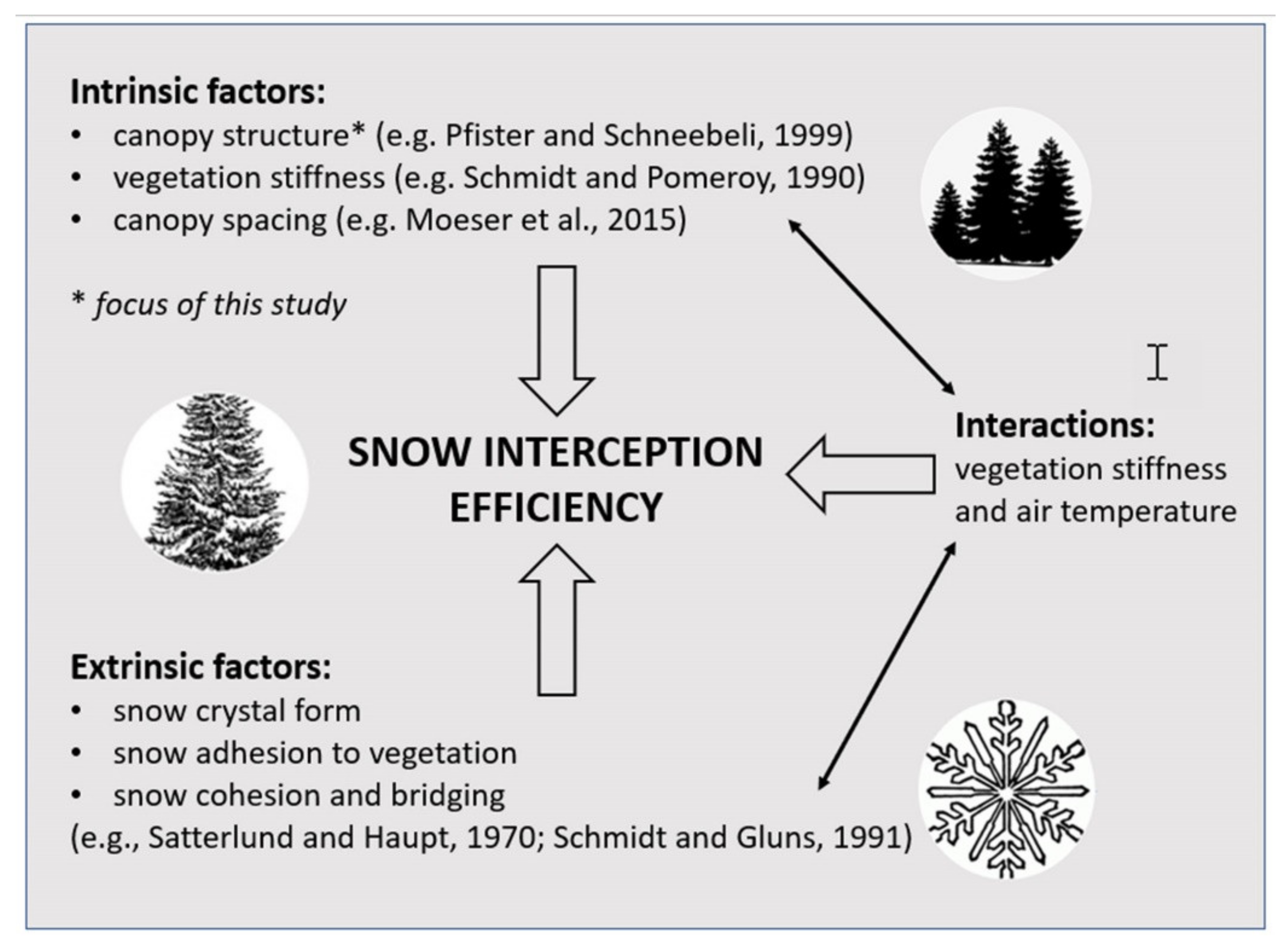


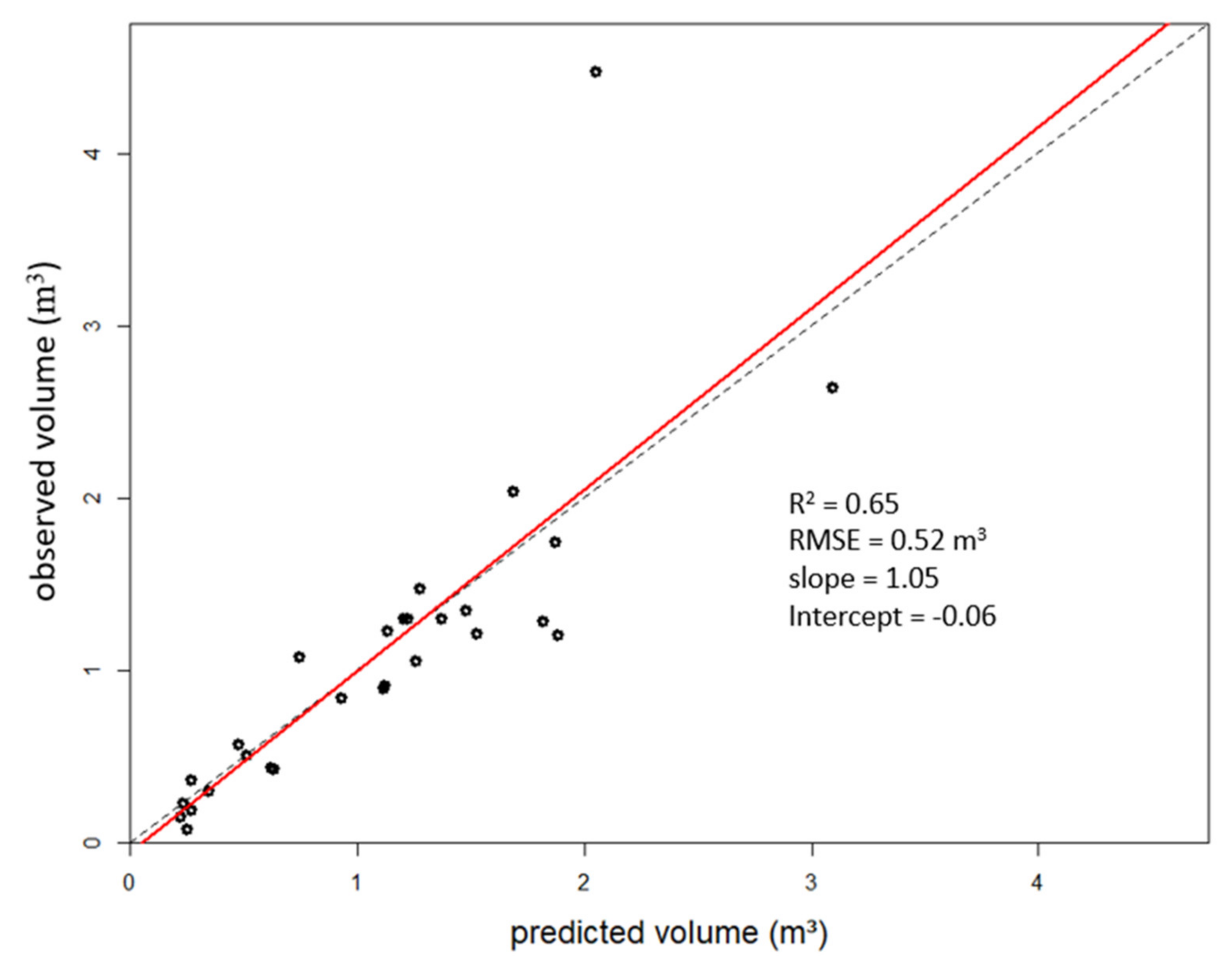
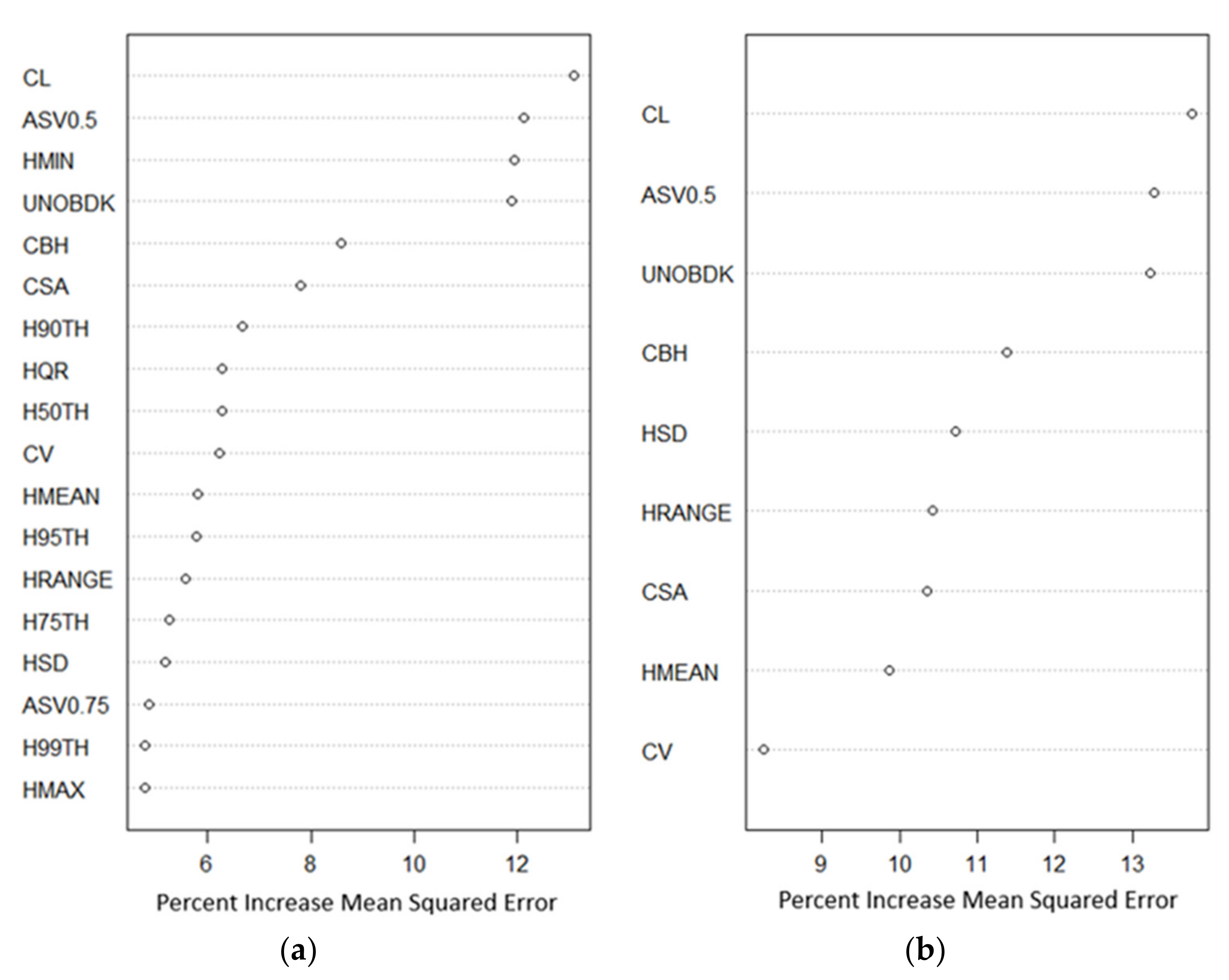
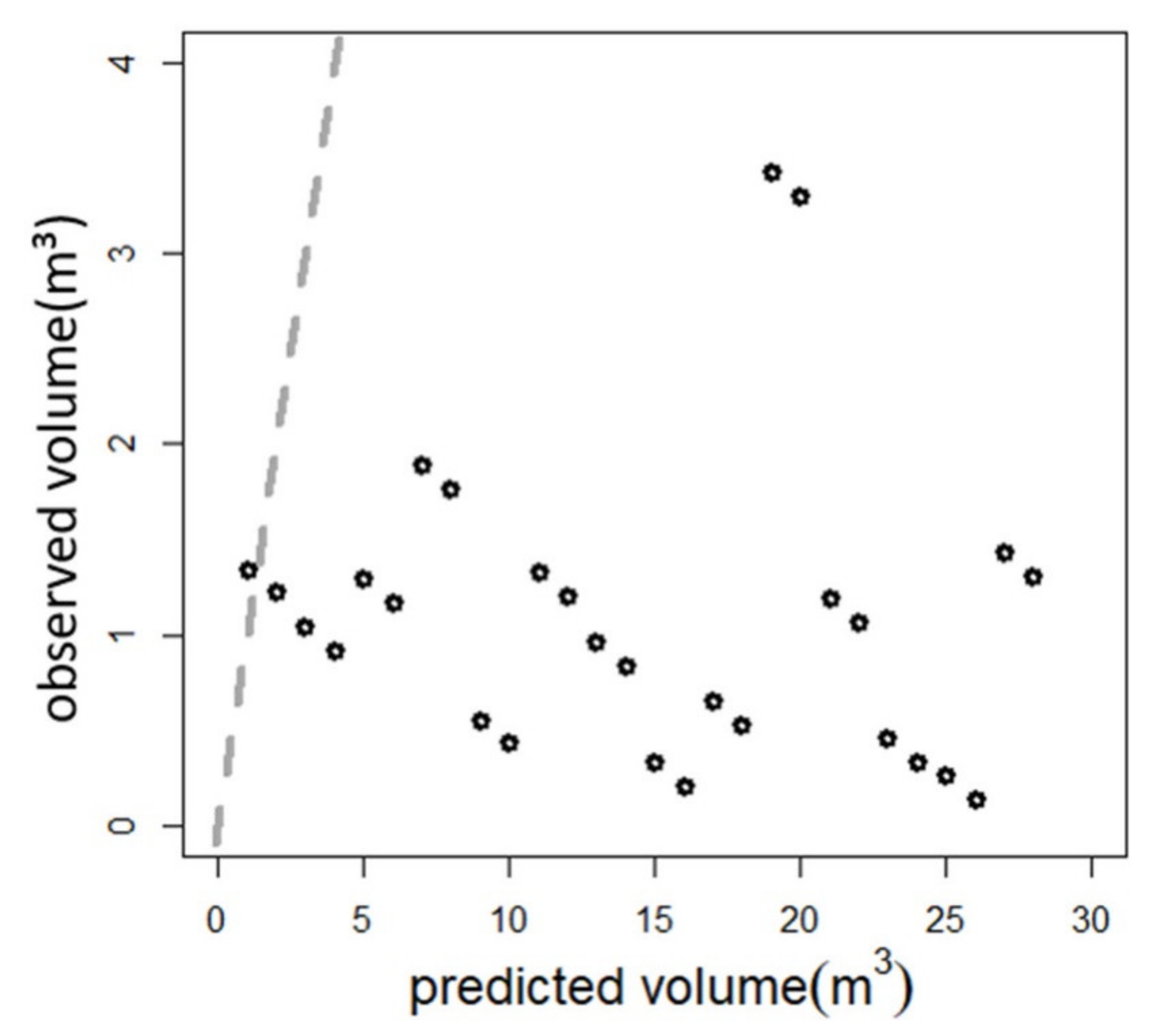
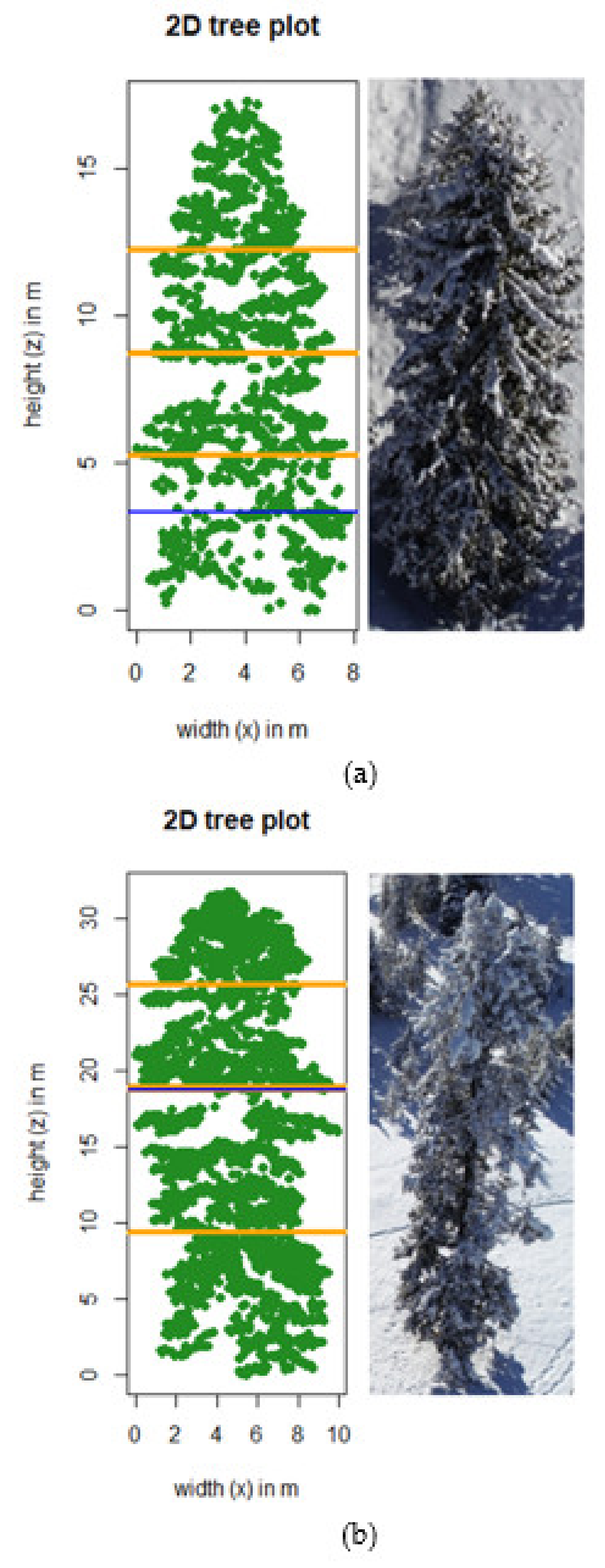
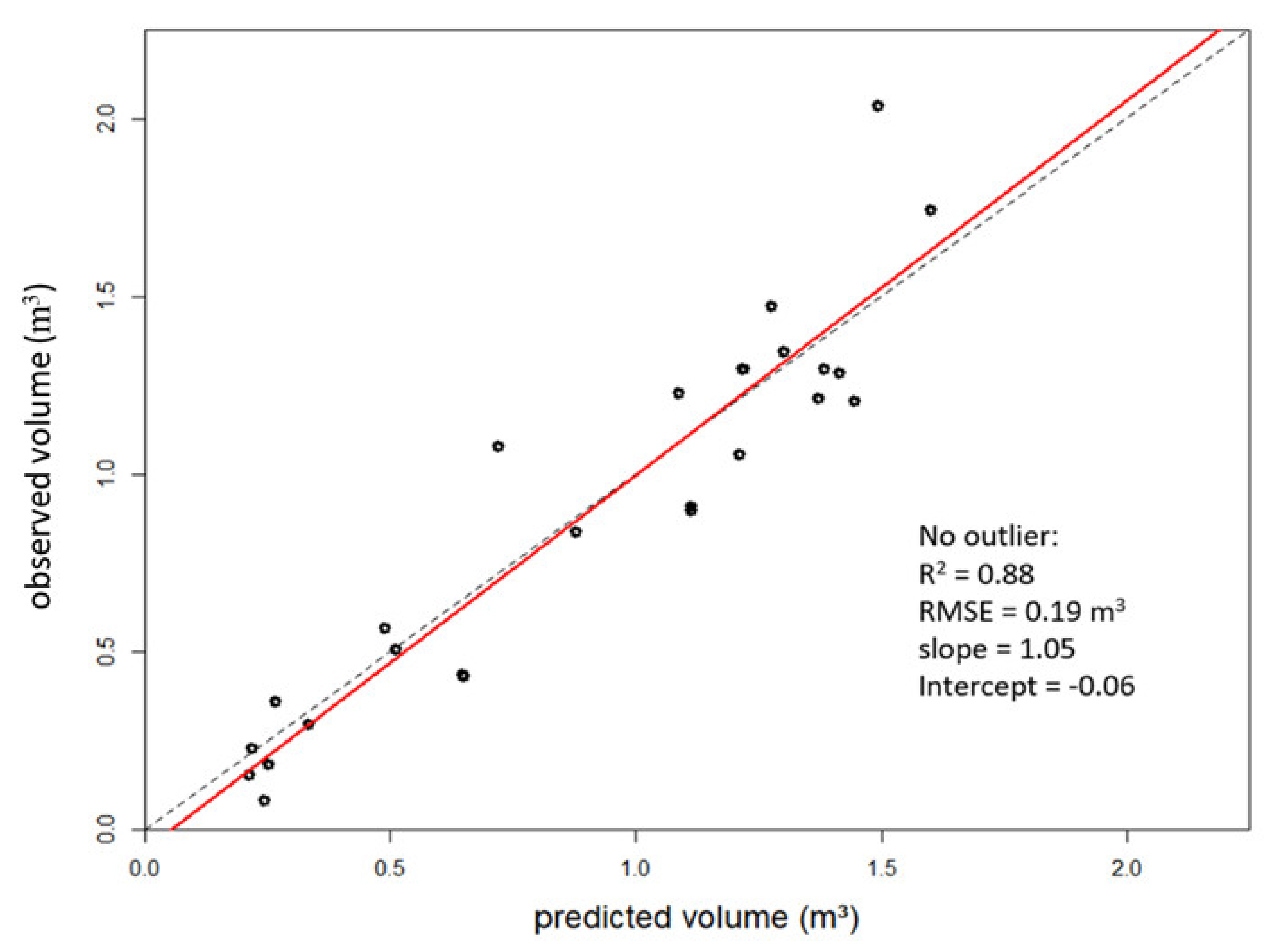
| Abbreviation | Definition |
|---|---|
| HMIN (m) | minimum crown height |
| HMAX (m) | maximum crown height |
| HMEAN (m) | mean crown height |
| HSD (m) | crown height standard deviation |
| HSKE | skewness of heights |
| HKUR | kurtosis of heights |
| HRANGE | HMAX-HMIN |
| HQR | interquartile range (H75TH–H25TH) |
| H25TH (m) | crown height 25th percentile |
| H50TH (m) | crown height 50th percentile |
| H75TH (m) | crown height 75th percentile |
| H90TH (m) | crown height 90th percentile |
| H95TH (m) | crown height 95th percentile |
| H99TH (m) | crown height 99th percentile |
| CL (m) | crown length (HMAX–CBH) |
| CBH (m) | crown base height (1.5 standard deviations below the height returns mean) |
| CRATIO | crown ratio (CL/HMAX) |
| CPA (m2) | crown area (π*CRAD2) |
| CV (m3) | crown volume as the convex hull 3D |
| CSA (m2) | crown surface area as the convex hull 3D |
| CDENS | percent crown density (returns ≥ CBH/total returns) |
| ASV0.25 | whole tree volume (α = 0.25) |
| ASV0.5 | whole tree volume (α = 0.50) |
| ASV0.75 | whole tree volume (α = 0.75) |
| UNOB | number of unobstructed returns * |
| UNOB% | percent unobstructed returns * |
| UNOBDK | number of unobstructed returns with decay function for weighted returns * |
| UNOBDK% | percent unobstructed returns with decay function for weighted returns * |
Publisher’s Note: MDPI stays neutral with regard to jurisdictional claims in published maps and institutional affiliations. |
© 2021 by the authors. Licensee MDPI, Basel, Switzerland. This article is an open access article distributed under the terms and conditions of the Creative Commons Attribution (CC BY) license (https://creativecommons.org/licenses/by/4.0/).
Share and Cite
Russell, M.; Eitel, J.U.H.; Link, T.E.; Silva, C.A. Important Airborne Lidar Metrics of Canopy Structure for Estimating Snow Interception. Remote Sens. 2021, 13, 4188. https://doi.org/10.3390/rs13204188
Russell M, Eitel JUH, Link TE, Silva CA. Important Airborne Lidar Metrics of Canopy Structure for Estimating Snow Interception. Remote Sensing. 2021; 13(20):4188. https://doi.org/10.3390/rs13204188
Chicago/Turabian StyleRussell, Micah, Jan U. H. Eitel, Timothy E. Link, and Carlos A. Silva. 2021. "Important Airborne Lidar Metrics of Canopy Structure for Estimating Snow Interception" Remote Sensing 13, no. 20: 4188. https://doi.org/10.3390/rs13204188
APA StyleRussell, M., Eitel, J. U. H., Link, T. E., & Silva, C. A. (2021). Important Airborne Lidar Metrics of Canopy Structure for Estimating Snow Interception. Remote Sensing, 13(20), 4188. https://doi.org/10.3390/rs13204188







